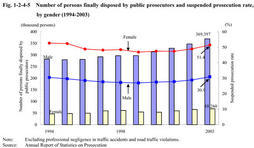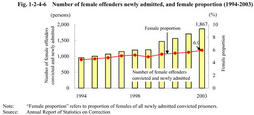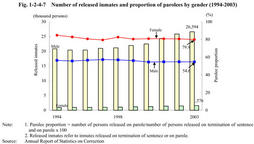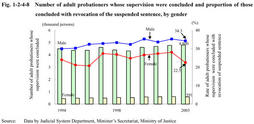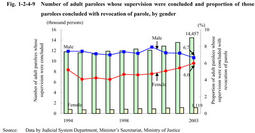| Previous Next Index Image Index Year Selection | |
|
|
3. Treatment of female offenders (1) Disposition by public prosecutors Fig. 1-2-4-5 shows the number of persons finally disposed by public prosecutors and suspended prosecution rate for non-traffic penal code offenses and special law offenses(excluding road traffic violations)over the last10years,by gender.Suspended prosecution rate for male offenders has been between25%and about30%whereas that rate for female offenders generally has been between45%and about54%,coming to51.4%in2003.
Fig. 1-2-4-5 Number of persons finally disposed by public prosecutors and suspended prosecution rate,by gender(1994-2003) (2) Correction of female offenders Fig. 1-2-4-6 shows the number of female offenders newly admitted to correctional institutions and female proportion in all newly admitted prisoners over the last10years.In2003,all newly admitted prisoners were31,355,up1,078(3.6%)from2002.Among them,females were1,867,up162(9.5%)from2002.Female proportion increased by0.4points from2002to6.0%.
Fig. 1-2-4-6 Number of female offenders newly admitted,and female proportion(1994-2003) Fig. 1-2-4-7 shows the number of released inmates and proportion of parolees in all released inmates over the last10years,by gender.Released inmates have increased for both males and females.On the other hand,the proportion of parolees has been stable at about55%for males and about80%for females.Fig. 1-2-4-7 Number of released inmates and proportion of parolees by gender(1994-2003) (3) Probationary supervision for female offenders Fig. 1-2-4-8 shows the number of adult probationers whose supervision were concluded and the proportion of those concluded with revocation of suspended sentence for the reason of committing crimes or breach of probation conditions over the last10years,by gender.Concluded adult probationers have remained flat or showed an upward trend.Of all those concluded,revoked proportion has fluctuated within the30-40%range for males and within the20-30%range for females,including34.3%for males and22.5%for females in2003.
Fig. 1-2-4-8 Number of adult probationers whose supervision were concluded and proportion of those concluded with revocation of the suspended sentence,by gender Fig. 1-2-4-9 shows the number of adult parolees whose supervision were concluded and the proportion of those parolees concluded with parole revocation for the reason of committing crimes or breach of parole conditions,over the last10years,by gender.Along with increased adult parolees under supervision,the number of concluded parolees has been on a rising trend.Of all those concluded,revoked proportion for male parolees has been in a downward trend at around7%,whereas revoked proportion for female parolees has recently rose to6.0%in2003,though still slightly below for males.Fig. 1-2-4-9 Number of adult parolees whose supervision were concluded and proportion of those parolees concluded with revocation of parole,by gender |
